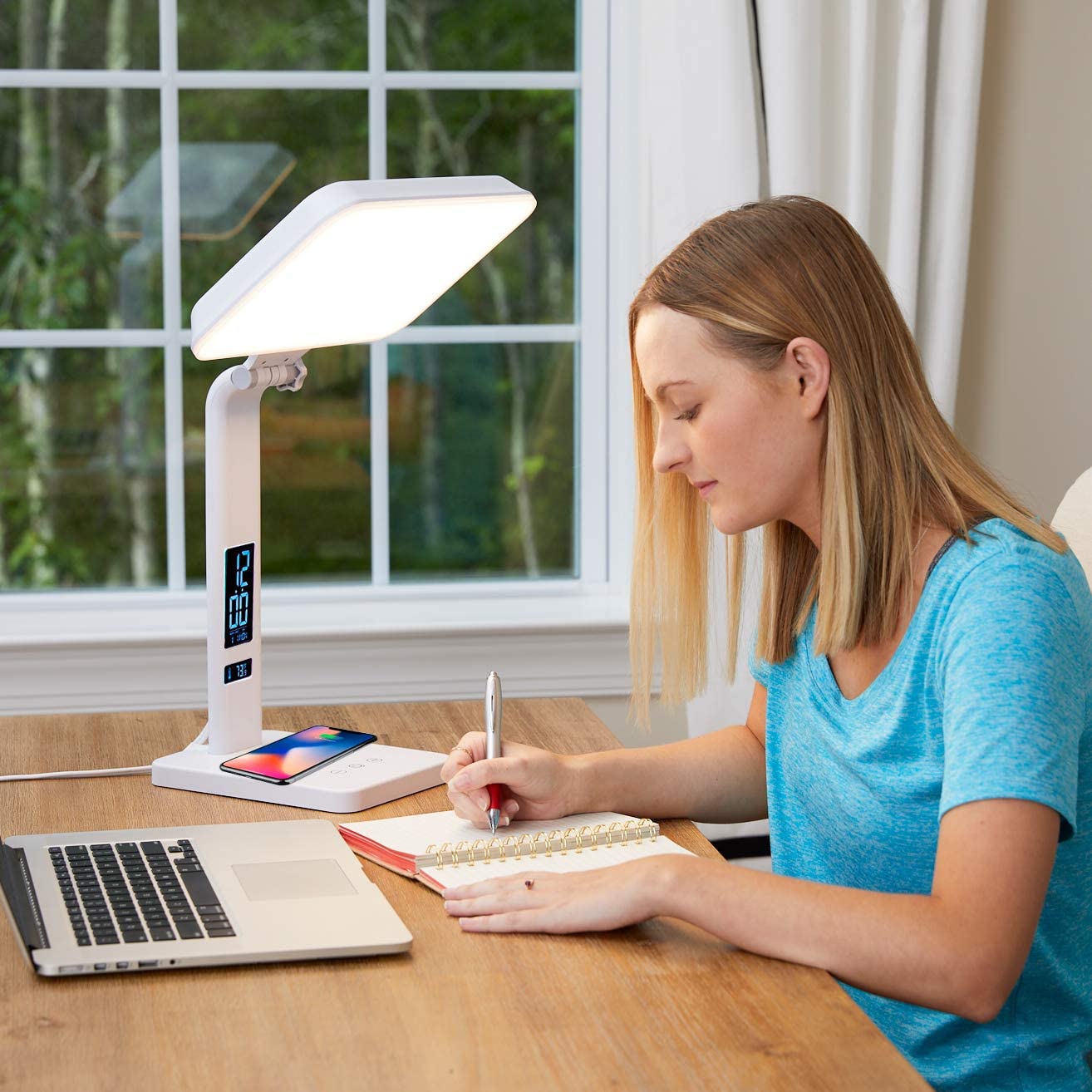
Selecting the Right Light Therapy Lamp
What Should I Look for in a Light Therapy Box?
Looking for a therapy lamp? Our buyer's guide breaks down the necessities when considering your purchase.
Author:START READING
Related Articles
- The Ultimate Guide to Bright Light Therapy
- Do Light Therapy Lamps Work? (Infographic)
- Light Therapy Lamp Buyer's Guide
- Light Therapy Lamp Product Quiz
With hundreds (if not thousands) of options, choosing a light therapy box can be challenging.
The perfect therapy lamp will boost your energy, sleep quality, and well-being, whereas the wrong lamp, well, won't do anything. For therapy lamps to be effective, they must meet a series of specifications. This includes:
- Producing enough LUX
- Blocking harmful UV rays
Not only that, but they also need to meet your lifestyle and size requirements. If you're new to bright light therapy, all of this can be daunting. This guide will simplify the selection process with critical essentials to consider before choosing a lamp.
What is a Light Therapy Lamp?
TL/DR
- Light therapy lamps are specialized lights designed to mimic sunlight.
- They're used to replenish sun exposure and used to treat seasonal depression, insomnia, jet lag, and more.
- They differ from standard lamps as they emit 5-20 times more LUX (light intensity).
- They're used each morning for 20-30 minutes to trick the body into producing serotonin and melatonin.
- They can help improve energy levels, enhance sleep quality, and relieve poor mental health.
A bright light therapy lamp (also called a SAD lamp or sun lamp) is a specially designed light made to mimic sunlight.
These lights help replenish sunlight exposure. They are often used to treat light-related conditions such as:
- Seasonal affective disorder (seasonal depression),
- Insomnia
- Jet lag
- And more.
How Does Phototherapy Work?
Light therapy is quite simple. It involves sitting in front of a light that mimics daylight each morning for 20 to 30 minutes. This tricks our body into producing two essential hormones: serotonin and melatonin.
Serotonin (which converts to melatonin) regulates mood, appetite, energy, sexual desire, and memory. Melatonin is vital to our sleep-wake cycle, known as our circadian rhythm.
By replenishing our access to sunlight, we're able to regulate our hormone levels to:
- Have more energy
- Sleep better
- And combat light-related health conditions.

Light therapy Lamps vs. Regular Lamps
A common misconception is you can get the same benefits from light therapy through regular lamps. While adequate lighting does help your sleep-wake, you won't get all the benefits of a therapy lamp from a standard light.
The proper therapy lamp produces 10000 LUX, and some have five to twenty times more LUX than standard lamps.
| Feature | Light Therapy Lamps | Regular Lamps |
|---|---|---|
| Purpose | Mimic sunlight to treat conditions like SAD | Provides general illumination |
| Light Color | Bright white or blue light | Warm or cool white light |
| Light Intensity | 10,00 LUX | 200-700 LUX |
| Duration of Use | Used in short sessions (20-30 minutes daily) | Used for longer periods throughout the day |
| Positioning | Placed directly in front of user's face | Can be placed anywhere |
| Special Features | May have filters, timers, and adjustable settings | Typically simple on/off switch |
| Safety | UV filter recommended, avoid staring directly at light | Generally safe for prolonged use |
| Costs | Typically more expensive than regular lamps | Affordable range of prices |
Why Use a Light Box?
The US Environmental Protection Agency reports Americans spend 90% of their time indoors, away from sunlight. This means we don't get all the benefits of the sun to lead a healthy life. And during colder months, getting outside can be challenging.
These specialized lights are an excellent alternative to sunlight. They can treat various mental health conditions, including seasonal depression, anxiety, and insomnia. They can also be used for those who want to enhance their physical, mental, and emotional wellbeing. And because they're relatively safe, you don't have to worry about any harmful side effects.
How to Choose a Light Box
Before selecting a lamp, it's vital to know what to look for in a light therapy lamp and why. In the age of mass production, it's easy to choose a lamp that looks great but provides no benefits.
This section will guide you through what to look for when buying a light therapy lamp.
| Aspect | What It Is | Why It's Important |
|---|---|---|
| 10,000 LUX | A measure of the light intensity at a specific distance from the lamp. | Often recommended as the most effective intensity for treating Seasonal Affective Disorder (SAD) and other circadian rhythm disorders within a reasonable timeframe (e.g., 20-30 minutes). |
| Circadian Light (CLA) | A metric that quantifies the effectiveness of light in suppressing melatonin and shifting the circadian rhythm. It considers the spectral sensitivity of non-visual photoreceptors in the eye. | Provides a more accurate measure of a lamp's potential to impact your sleep-wake cycle compared to LUX alone. Lamps with higher CLA values are generally more effective for circadian regulation. |
| Glare (LUX/in2) | The intensity of light concentrated within a small area, which can cause discomfort or visual strain. | High glare can lead to eye fatigue, headaches, and reduced comfort during use. Look for lamps designed to minimize glare through diffusers or proper light distribution. |
| Color Temperature (K) | Measured in Kelvin, it describes the "warmth" or "coolness" of the light. Lower numbers (e.g., 2700K) are warmer (yellowish), while higher numbers (e.g., 5000-6500K) are cooler (bluish-white). | Cooler, bright white light is generally considered more effective for alertness and circadian rhythm shifting, mimicking daylight. However, personal preference and comfort should also be considered. |
| Light Spectrum | The range of wavelengths emitted by the lamp. | A full or broad spectrum light is generally preferred as it mimics natural daylight more closely. Some research suggests that certain wavelengths are more effective for specific benefits. |
| Ultraviolet (UV) Light Protection | Features designed to filter out harmful UV radiation emitted by the lamp. | Essential for eye safety and to prevent potential skin damage associated with UV exposure. Ensure the lamp explicitly states it offers UV protection. |
| LED or Fluorescent | The type of light source used in the lamp. | LED: Generally more energy-efficient, longer-lasting, and often flicker-free. Fluorescent: Can be less expensive initially but may have a shorter lifespan and potential for flicker in some models. |
| Your Condition (Medical-Grade vs Wellness Grade Lamps) | Categorization based on intended use and regulatory standards. Medical-grade lamps may have specific certifications or claims related to treating diagnosed conditions. Wellness-grade lamps are generally for general well-being. | Medical-Grade: Necessary if you have a diagnosed condition like SAD and are using light therapy as a prescribed treatment. May require specific features and certifications. Wellness-Grade: Suitable for general mood enhancement, energy boosting, and circadian rhythm support. |
| Size | The physical dimensions of the lamp. | Consider where you plan to use the lamp (desk, bedside table, travel). Size impacts portability, storage, and the area of light coverage. |
| Lifestyle (Travel Often) | Your typical routines and whether you frequently move locations. | If you travel often, consider a smaller, more portable light therapy lamp that is easy to pack and set up in different locations. |
| Light Sensitivity (Various Brightness Settings) | The ability to adjust the intensity (LUX) of the light emitted by the lamp. | Crucial for individuals with light sensitivity or those who prefer to start with a lower intensity and gradually increase it. Offers greater comfort and customization of the light therapy experience. |
| Light Angle | The adjustability of the lamp's head or light panel. | Allows you to direct the light towards your eyes at the recommended angle (typically downward) without looking directly into the light source, maximizing effectiveness and comfort. |
| Extra Features | Additional functionalities included in the lamp. | Features like a wireless phone charger, USB port, or alarm clock can add convenience and integrate the light therapy lamp into your daily routine more seamlessly. |
| Brand Return Policy and Warranty | The terms and conditions for returning the lamp if it doesn't meet your needs and the duration of the manufacturer's guarantee against defects. | Important for peace of mind. A good return policy allows you to try the lamp risk-free, and a solid warranty protects your investment against manufacturing issues. |
Key Specifications to Look for

10,000 LUX: The Most Effective Light Intensity
10,000 LUX is the #1 most important specification to look at when choosing any therapy lamp. LUX is the amount of light a device produces on a given surface. While lamps that produce less will work, numerous studies have found less LUX to take more time to deliver benefits compared to 10,000 LUX.
Yale reports that, "Intensity of light is important because many experts believe there is a trade off between lux and duration: 30 minutes of exposure at 10,000 lux is thought to be equivalent to 60 minutes at 5,000 lux or 120 minutes at 2,500 lux."
Circadian Light (CLA): How Effective the Light Suppresses Melatonin and Shifts Your Circadian Rhythm
Traditionally speaking LUX has been the primary way to measure the effectiveness of light therapy. However, there is a newer and possibly more effective method of measuring a lamp's effectiveness: Circadian Light (CLA)
While LUX measures a lamps brightness, CLA goes beyond that. It measures the specific wavelengths (colors) that most effectively stimulate your circadian rhythm (sleep-wake cycle). CLA looks at the spectral power distribution, which is the amount of each light color. It also considers how these colors affect your circadian rhythm.
A lamp with a high CLA is beneficial for many reasons:
- Stronger Wake-Up Signal. A lamp with a higher CLA is better at reducing melatonin, the sleep hormone. It also helps release cortisol, a hormone linked to alertness.
- Facilitating Circadian Shift. For those with conditions like SAD or those trying to shift their sleep-wake cycle earlier, a more potent circadian stimulus in the morning can help to advance the timing of their internal clock.
- Improved Alertness and Mood. A therapy lamp with a stronger circadian signal can improve morning alertness, energy, and mood.
When choosing a therapy lamp, remember that both intensity (lux) and the spectral quality (CLA) play a role. Considering CLA can help you find a lamp that's truly effective in supporting your circadian rhythm and overall well-being.
Glare (Lux/in2): Less Glare Equals Better Eye Comfort
While a high-intensity lamp is essential to for effective treatment, so is its comfort level. Glare occurs when too much light enters your eyes leading to discomfort and reduction in eyesight. A lamp with a high glare can cause discomfort, eye strain, and even headaches.
Light therapy lamps must produce high intensity to be effective. However, an equally effective and comfortable lamp will incorporate a few features to reduce glare, including:
- Diffuser: This sits over the lamps LEDs to scatter light evenly to reduce discomfort
- Large surface area: A large surface area helps spread the light source out so it's not as concentrated on your eyes
- Downward projection: Directing light downward helps in avoiding direct eye exposure
A good way to measure a lamp's glare is to divide its LUX by the size of its light source in square inches. Theoretically, a lamp with a lower value will be more comfortable to use. However, the lamp's comfort level will vary from person to person.
When considering a lamp, be sure to look for terms such as "glare-free". A lamp that's glare-free has considered comfort in its design.
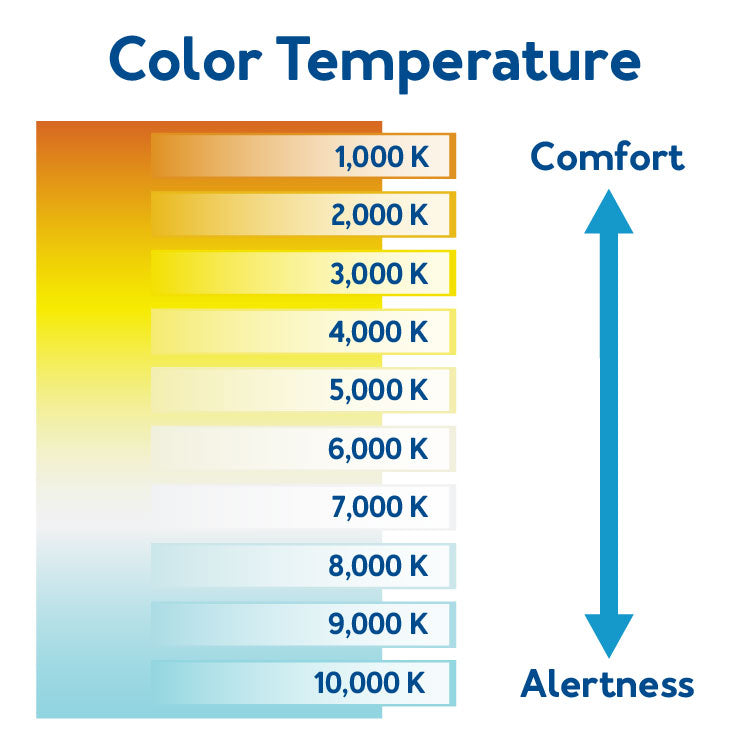
Color Temperature: Promoting Comfort or Alertness
A critical area often considered when selecting a SAD lamp is blue or white color. The color temperature of light refers to its "warmth" or "coolness" which is measured in kelvin (K). Warmer lights, around 1,000 K, promote comfort and have a calming effect. Cooler lights, around 10,000 K, promote alertness.
White lights, on the other hand, are in the 5,000 to 7,000 K range. These promote alertness but are easier on the eyes. You'll notice most offices use lights in this color temperature range.
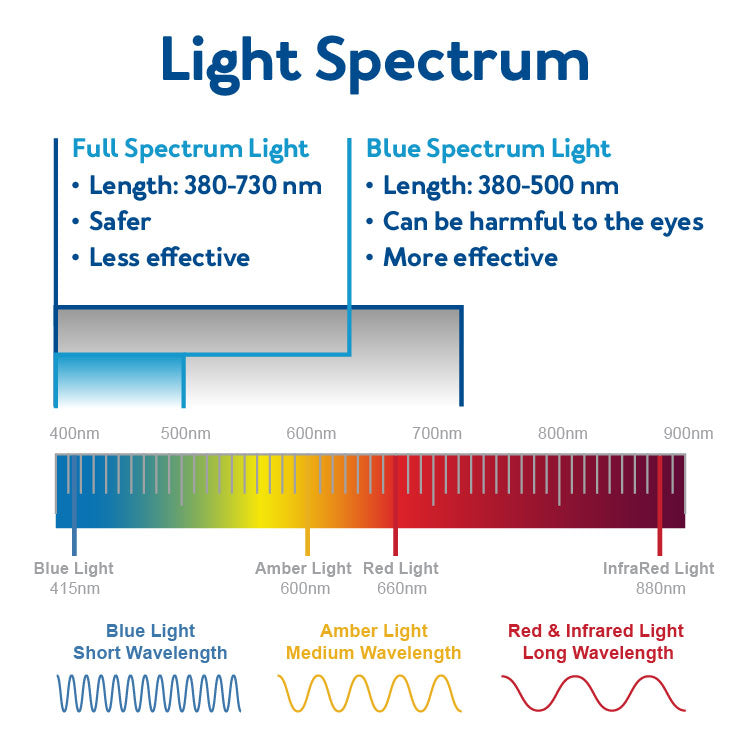
Light Spectrum: Blue vs Full-Spectrum
A significant aspect to consider is the light spectrum a lamp uses. Therapy lamps typically produce blue or full-spectrum light therapy.
When compared to full-spectrum, blue light has been proven to be more effective in treating SAD. However, it can be harmful to the eyes. This is especially true if the user is on any medications. Full-spectrum light boxes use traces of blue light but are much safer to use.

Ultraviolet (UV) Light Protection: Prevent Skin Damage
Many types of light produce ultraviolet light (UV). UV light is an invisible type of light that sits between visible light and X-ray on the electromagnetic spectrum.
While UV light has many uses, extensive exposure can cause skin damage. Because of this, it's vital to select a UV-free light therapy lamp. The proper 10000 LUX light will feature a built-in filter that keeps UV from reaching the user.

LED or Fluorescent
Older 10000 LUX energy light lamps tend to use fluorescent bulbs. They have since then been replaced with LED (light-emitting diode) bulbs. LEDs are notoriously safer, more energy-efficient & durable, and last much longer compared to fluorescent bulbs.
If you're considering purchasing a model that uses fluorescent bulbs, they will need to be replaced much quicker.
Your Preferences & Conditions

Your Condition
For people with diagnosed health conditions like seasonal affective disorder, it is important to use a medical-grade lamp. These lights deliver the maximum amount of light for optimal results. If you only have minor issues, a health/wellness rated lamp will work as well. Consult your doctor if you have any questions/concerns.
| Medical Grade Lamps | Wellness Grade Lamps |
|---|---|
| Are larger Direct light downward from an upward position Produce 10,000 LUX from 12" away | Are made to treat milder conditions Are typically smaller May produce 10,000 LUX, but this is usually from 10" |

Where are You Putting Your Lamp?
Each of our lamps offers different dimensions and sizes for different areas. If the location you'll be putting your lamp in is compact, then you should consider one of our smaller models.
Smaller sun lamps for office use can help with more severe cases of seasonal depression. However, they will need to be sat in front of for more extended periods.

Your Lifestyle
If you travel a lot, you'll need a portable light box for SAD. These are compact, which makes them easy to use anywhere and pack in luggage. If you struggle with jet lag often, then a smaller therapy lamp might be a must-have. They can help combat the adverse side effects of traveling to varying time zones.

Light Sensitivity
If you are sensitive to light, you might want to consider one of our models that feature different light brightness settings. Some may struggle with a light that can only be on/off without customizing the light intensity.
Lamps with adjustable intensity also double as a standard desk lamp. You can use them for light therapy sessions and then turn them down as a task lamp.
Features & Extras

Light Angle
If you are placing your therapy lamp in a crowded space, you'll want a lamp that offers flexibility with an adjustable angle. This will give you the option to adjust accordingly to your area. If you're looking for a medical-grade light therapy lamp, it should point light down from an upward angle. This allows light to reach the top of your eyes, just like the sun does.

Additional Features
There are many SAD light specifications to consider from. One area you might be interested in is additional features. Newer lamps may feature extra features such as a:
- Wireless phone charger
- USB port
- Alarm clock
- And more.
These features can further enhance the user experience.
Brand Return Policy & Warranty
As with any product, purchasing from a trusted brand is important. Any trustworthy brand will have a return policy and warranty in place for its customers. Consider these questions:
- What happens if I end up not liking the product, can I return it?
- What is the length of the return policy?
- What does the return process look like? Is it convenient?
- What happens if the product breaks? Is there a warranty in place?
- How long is the warranty and what's covered under it?
Our Day-Light lamps come with a five-year warranty and our TheraLite lamps come with a one-year warranty. Each warranty covers the lamp under normal use should it malfunction or break.
Additionally, we offer a 90-day return policy. If our lamps don't live up to your expectations or you realize you have no use for them, you can return it within 90-days of purchase.
SAD Light Comparison Chart
Below, you'll find our complete collection of full-spectrum lights for SAD. All of our lamps provide safe and effective full-spectrum light therapy at 10000 LUX. We offer a wide variety of full-spectrum sun lamps in different sizes, shapes, and distinct features. Our Day-Light and TheraLite brands have been a trusted leader of full-spectrum light box therapy and featured in numerous publications.
#1 Seller

Day-Light Classic Plus
- Classification: Clinical
- Sunlight Deprivation: Severe
- LUX Ouput: 10,000 LUX @ 12”
- Screen Size: 16" x 13"
- Color Temp: 4000K
- Height Adjustable: ✔️
- Angle Adjustable: ✔️
- Projects Light from Above: ✔️
- No. of Light Settings: 2
- Includes Alarm Clock: ❌
- Includes Wireless Charging: ❌
Contemporary Design
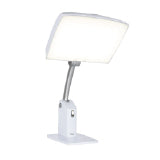
Day-Light Sky
- Classification: Clinical
- Sunlight Deprivation: Severe
- LUX Ouput: 10,000 LUX @ 12”
- Screen Size: 13.5 x 10"
- Color Temp: 4000K
- Height Adjustable: ✔️
- Angle Adjustable: ✔️
- Projects Light from Above: ✔️
- No. of Light Settings: 2
- Includes Alarm Clock: ❌
- Includes Wireless Charging: ❌
#1 Wellness Lamp

TheraLite Aura
- Classification: Wellness
- Sunlight Deprivation: Moderate
- LUX Ouput: 10,000 LUX @ 12”
- Screen Size: 11.25" x 8"
- Color Temp: 3000K
- Height Adjustable: ❌
- Angle Adjustable: ✔️
- Projects Light from Above: ✔️
- No. of Light Settings: 4
- Includes Alarm Clock: ❌
- Includes Wireless Charging: ❌
Tech-Heavy

TheraLite Aura Qi
- Classification: Wellness
- Sunlight Deprivation: Moderate
- LUX Ouput: 10,000 LUX @ 12”
- Screen Size: 11.25" x 8"
- Color Temp: 3000K
- Height Adjustable: ❌
- Angle Adjustable: ✔️
- Projects Light from Above: ✔️
- No. of Light Settings: 4
- Includes Alarm Clock: ✔️
- Includes Wireless Charging: ✔️
Includes Wireless Charger
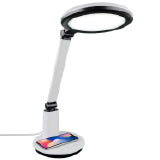
TheraLite Halo
- Classification: Wellness
- Sunlight Deprivation: Moderate
- LUX Ouput: 10,000 LUX @ 10”
- Screen Size: 7" x 7"
- Color Temp: 3000K
- Height Adjustable: ❌
- Angle Adjustable: ✔️
- Projects Light from Above: ✔️
- No. of Light Settings: 4
- Includes Alarm Clock: ❌
- Includes Wireless Charging: ✔️
Emits Light from 360°

Bright Health 360° - 14"
- Classification: Wellness
- Sunlight Deprivation: Moderate
- LUX Ouput: 10,000 LUX @ 14"
- Screen Size: 14" x 7.5"
- Color Temp: 4000K
- Height Adjustable: ❌
- Angle Adjustable: ❌
- Projects Light from Above: ❌
- No. of Light Settings: 4
- Includes Alarm Clock: ❌
- Includes Wireless Charging: ❌
Emits Light from 360°

Bright Health 360° - 24"
$119.99
- Classification: Wellness
- Sunlight Deprivation: Moderate
- LUX Ouput: 10,000 LUX @ 12"
- Screen Size: 24" x 7.5"
- Color Temp: 4000K
- Height Adjustable: ❌
- Angle Adjustable: ❌
- Projects Light from Above: ❌
- No. of Light Settings: 4
- Includes Alarm Clock: ❌
- Includes Wireless Charging: ❌
Tech-Heavy
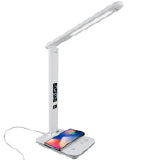
TheraLite Radiance
- Classification: Wellness
- Sunlight Deprivation: Moderate
- LUX Ouput: 10,000 LUX @ 10”
- Screen Size: 1.5" x 6.5"
- Color Temp: 3000K
- Height Adjustable: ❌
- Angle Adjustable: ✔️
- Projects Light from Above: ✔️
- No. of Light Settings: 4
- Includes Alarm Clock: ✔️
- Includes Wireless Charging: ✔️
Hangs Up
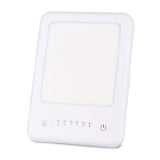
TheraLite Glow
- Classification: Wellness
- Sunlight Deprivation: Moderate
- LUX Ouput: 10,000 LUX @ 6”
- Screen Size: 8.75" x 6.5"
- Color Temp: 4000K
- Height Adjustable: ❌
- Angle Adjustable: ❌
- Projects Light from Above: ❌
- No. of Light Settings: 4
- Includes Alarm Clock: ❌
- Includes Wireless Charging: ❌
Adjustable Head

TheraLite Compact
- Classification: Wellness
- Sunlight Deprivation: Moderate
- LUX Ouput: 10,000 LUX @ 10”
- Screen Size: 9.2” x 5.3”
- Color Temp: 3000K
- Height Adjustable: ✔️
- Angle Adjustable: ✔️
- Projects Light from Above: ❌
- No. of Light Settings: 1
- Includes Alarm Clock: ❌
- Includes Wireless Charging: ❌
Minimalistic
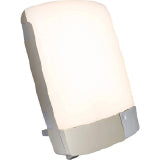
Carex Sunlite
- Classification: Wellness
- Sunlight Deprivation: Moderate
- LUX Ouput: 10,000 LUX @ 10”
- Screen Size: 12.2" x 8.7"
- Color Temp: 3000K
- Height Adjustable: ❌
- Angle Adjustable: ❌
- Projects Light from Above: ❌
- No. of Light Settings: 1
- Includes Alarm Clock: ❌
- Includes Wireless Charging: ❌
Helpful Light Therapy Related Resources
About the Author

Brandon Landgraf is the Digital Marketing Manager for Carex Health Brands. He finds passion and fulfillment in creating content that enhances, improves, and enlivens others' quality of life. All of his written work is formulated to not only offer essential advice and tips but back it with proven studies and experts. His mission is to connect with readers and provide steps to make their lives better.
About Carex Health Brands
Carex is your one-stop shop for home medical equipment and for products that assist caregivers with providing the best possible support and care for their loved ones. Carex Health Brands has been the branded leader in in-home, self-care medical products for over 35 years. Our goal is to improve the lives of our customers by bring them quality products that bring dignity back to their lives. With our three nationally distributed brands, Carex Health Brands serves national, regional and independent food, drug and mass retailers along with wholesalers, distributors and medical dealers.


